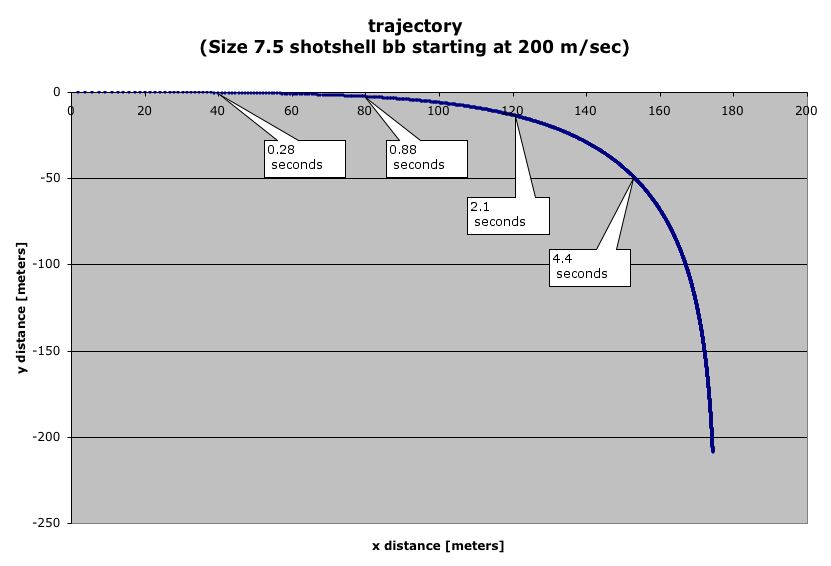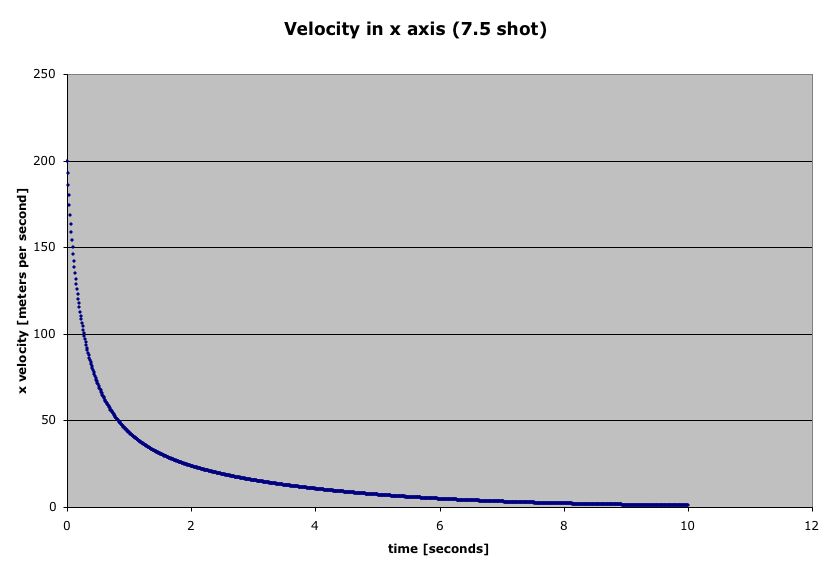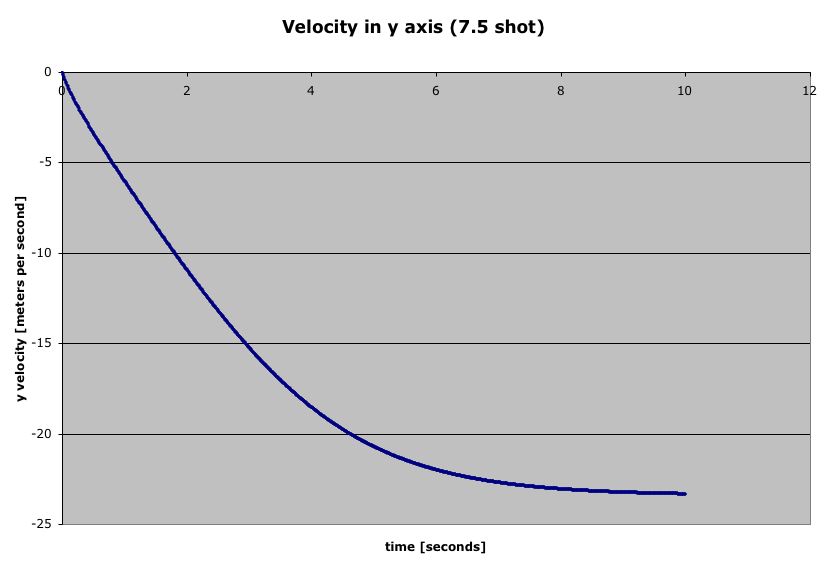


| MadSci Network: Physics |
This is the subject of ballistics. A search using the Google search engine on the Web turns up, among others, this very good page. There is also a previous answer in our archives discussing the terminal velocity of a shot bb coming back down after having been fired straight up. Using that previous answer the vertically-falling terminal velocity of the 7.5-size shot bb is about 23.4 meters per second (diameter is 0.094 inch; density is 11.36 g/cm3).
For a projectile being shot horizontally, the horizontal velocity would eventually become zero even if there weren't things in the way such as trees, the ground, etc., due only to the drag of the air. Given enough height so that the shot can actually attain a vertical (or almost vertical) flight its velocity would eventually be vertical, with a magnitude of the terminal velocity of about 23.4 meters per second.
In the bb's flight between being fired and eventually travelling vertically downward at its terminal velocity, the velocity will be the vector sum of the horizontal velocity and the vertical velocity. For example, if the bb is still going horizontally at 100 meters per second and has attained a vertical velocity of -2 meters per second, the vector sum of these is a velocity of 100.4 meters per second at an angle of 1.1 degrees below horizontal. (By the way, as you will see below, these are actual numbers from a numerical simulation I did.)(I discovered on several Internet sites devoted to shotgun information that the early part of the flight of shotshell balls can not be assumed to be as I have in my derivation, because the collective flight of a group of shotshell balls affects the air surrounding the group. Only as the group disperses is the drag on each individual ball like I have described. But I am ignoring this fact in my derivation, so there is some error.)
To solve this problem exactly is beyond the capabilities of integral calculus (solving differential equations) because the components of the drag in orthogonal axes are not separable if one uses the assumption that the drag is proportional to the square of the velocity. Some usable, but not exact, results can be obtained by assuming that the drag is linearly proportional to the velocity. Some results using that assumption are to be found in various places on the Internet, such as the first URL I gave above.
As a (very good) approximation to reality, using an approach that has been used by none other than NASA and the Department of Defense, the trajectory can be closely approximated, to very small errors, by assuming that the velocity and drag do not change much over a sufficiently small interval of time. In this way the velocities in the horizontal and vertical directions can be calculated separately, and for sufficiently small time intervals the errors are not great. Here is the approach: We know the starting x velocity and y velocity. In the particular case under consideration vx = 200 meters per second, let's say, and vy = 0, since we're firing the shotshell horizontally. (200 meters per second is a reasonable muzzle velocity for number 7.5 shot, as I found at various places on the Internet.) Since we know both vx and vy we can calculate the total velocity, the angle of flight, and the drag. The drag is directed directly opposite the velocity, and its components can be decomposed into the horizontal and vertical components. Thus we know the forces acting horizontally and vertically, and over the (small) time interval we assume constant force, thus allowing us to compute the velocities (horizontal and vertical) at the end of the time interval. These new velocities are used to compute the total velocity and drag for the following interval, and on and on. The process continues for as many intervals as we need. If the accuracy and precision are not sufficient, we can reduce the time interval. The limit in reduction of the time interval depends on the computer resources available.
In the x dimension the only force is the drag, so over the time interval dt and with the x component of the drag being Rx, the acceleration is -Rx/m, and the change in the x velocity is (-Rx/m)*dt. It's very similar in the y dimension except that there is the acceleration of gravity, so the change in the y velocity is (-g-Ry/m)*dt. The mass of the bb, m, can be calculated from the volume of the bb and its density.
I have done exactly the process described, using the program Excel. Below are some images
of the charts developed using the strategy described above.



There are many things to notice about these results. At time 0.88 seconds the bb has gone about 80 meters downrange and has fallen about 2.6 meters, while its horizontal velocity has already fallen to about 47.5 meters per second and its vertical velocity has increased to -5.4 meters per second. At time 2.1 seconds the bb has gone about 120 meters downrange and has fallen about 13 meters, while its horizontal velocity has fallen to about 22.7 meters per second and its vertical velocity has increased to -11.4 meters per second. The limits as time goes on are for the horizontal velocity to approach zero, as we surmised at the beginning of this long article, while the vertical velocity approaches -23.4 meters per second, the terminal velocity.
The Excel file that I used for this simulation is very interesting, and I will gladly email it to you if you desire. I suggest that you get this Excel file and examine it in detail, especially the formulae. The physics is actually quite simple in this simulation, while the results are amazingly satisfying.
Your question concerning the 7.5 size bb is whether it could do any damage at 225 yards range. According to my simulation they never get that far!! As I mentioned above, however, the early stages of the trajectory are influenced by the group of balls, and my simulation does not take that into account, so perhaps the balls can actually go as far as 225 yards. If the simulation is anywhere close to being accurate, though, then the balls will not go very far before they strike the ground. Also, they lose much of their velocity in the first second of flight (again ignoring the packet, or group, effects), so at a large range they will not be going very fast. According to the simulation the velocity is down to about the terminal velocity after only 2 seconds of flight, and the balls have only gone downrange about 120 meters at that time!
John Link, MadSci Physicist
Try the links in the MadSci Library for more information on Physics.